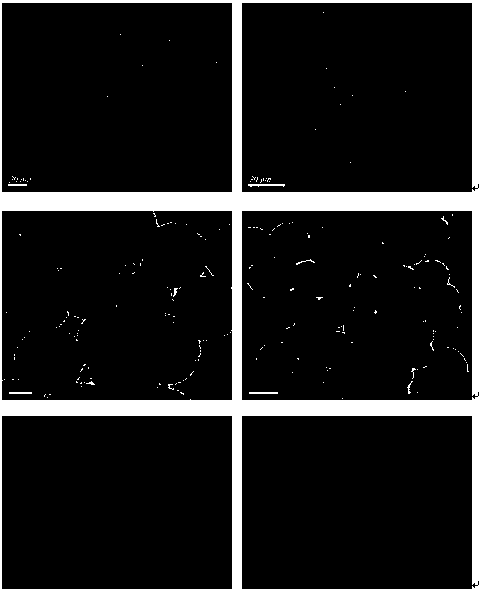Preparation method for quantum dot fluorescent imprinted polymer
A technology of imprinting polymers and quantum dots, applied in fluorescence/phosphorescence, chemical instruments and methods, luminescent materials, etc., can solve the problems of lack of universality and selectivity, low sensitivity, slow speed, etc., and achieve good optical stability. , the effect of sensitivity and selectivity improvement
- Summary
- Abstract
- Description
- Claims
- Application Information
AI Technical Summary
Problems solved by technology
Method used
Image
Examples
Embodiment 1
[0029] Add 30.3 mg of sodium borohydride and 51.04 mg of tellurium powder into a 5.0 mL syringe, then add 2.0 mL of double-distilled water, place the syringe in a container filled with water, and keep the reaction overnight. The final white liquid is The desired precursor NaHTe.
[0030] Inject the newly obtained precursor NaHTe into the CdCl in the presence of thiomalic acid (MSA) at a pH of 10.5 with nitrogen and deoxygenation 2 In aqueous solution, the CdCl added 2 2.5H 2 The masses of O and MSA are 182.688 mg and 300.3 mg, respectively. Mixed solution under nitrogen protection 100 o Under the condition of C, reflux reaction was carried out for 60 minutes, and yellow-green quantum dots with the desired wavelength of 558 nm were obtained.
[0031] Add 15 mL of cyclohexane, 3.2 mL of Triton-100, and 3.2 mL of n-hexanol into a three-necked flask, stir for 10 min, then add 600 μL of the prepared CdTe quantum dot aqueous solution, continue stirring for 15 min, then add 100 μ...
Embodiment 2
[0033] 60.6 mg sodium borohydride (NaBH 4 ) and 51.04 mg of tellurium powder were added to a 5.0 mL syringe, then 2.0 mL of double distilled water was added, the syringe was placed in a container filled with water, and the reaction was kept overnight. The final white liquid was the desired precursor NaHTe.
[0034] Inject the newly obtained precursor NaHTe into the CdCl in the presence of thiomalic acid (MSA) at pH 11.5 with nitrogen and deoxygenation 2 In aqueous solution, the CdCl added 2 2.5H 2 The masses of O and MSA are 456.72 mg and 450.45 mg, respectively. The mixed solution was protected under nitrogen at 110 o Under the condition of C, the reaction was refluxed for 20 minutes, and the green quantum dots with the required wavelength of 526nm were obtained.
[0035] Add 15 mL of cyclohexane, 3.6 mL of Triton-100, and 3.6 mL of n-hexanol into a three-necked flask, stir for 20 min, then add 800 μL of the prepared CdTe quantum dot aqueous solution, continue stirring f...
Embodiment 3
[0037] 45 mg sodium borohydride (NaBH 4 ) and 51.04 mg of tellurium powder were added to a 5.0 mL syringe, then 2.0 mL of double distilled water was added, the syringe was placed in a container filled with water, and the reaction was kept overnight. The final white liquid was the desired precursor NaHTe.
[0038] Inject the newly obtained precursor NaHTe into the CdCl in the presence of thiomalic acid (MSA) at a pH of 11.2 2 In aqueous solution, the CdCl added 2 2.5H 2 The masses of O and MSA are 365.376 mg and 375.375 mg, respectively. Mixed solution under nitrogen protection 105 o Under the condition of C, the reaction was refluxed for 6 hours, and the red quantum dots with the desired wavelength of 650 nm were obtained.
[0039] Add 15 mL of cyclohexane, 3.5 mL of Triton-100, and 3.5 mL of n-hexanol into a three-necked flask, stir for 15 min, then add 700 μL of the prepared CdTe quantum dot aqueous solution, continue stirring for 20 min, then add 150 μL TEOS and 100 μ...
PUM
 Login to View More
Login to View More Abstract
Description
Claims
Application Information
 Login to View More
Login to View More - R&D
- Intellectual Property
- Life Sciences
- Materials
- Tech Scout
- Unparalleled Data Quality
- Higher Quality Content
- 60% Fewer Hallucinations
Browse by: Latest US Patents, China's latest patents, Technical Efficacy Thesaurus, Application Domain, Technology Topic, Popular Technical Reports.
© 2025 PatSnap. All rights reserved.Legal|Privacy policy|Modern Slavery Act Transparency Statement|Sitemap|About US| Contact US: help@patsnap.com



